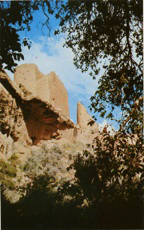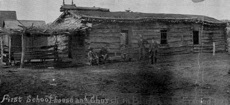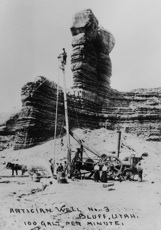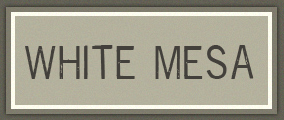Demography
 Located twelve miles south of Blanding, Utah, the community of White Mesa has a population of about 380 people and is part of the larger Ute Mountain Ute tribe headquartered in Towaoc, Colorado. White Mesa operates as a branch of the Ute Mountain Ute tribe and is governed by a seven-member board. The Ute Mountain Utes’ tribal lands, which total about 597,000 acres, are divided up in checkerboard-style allotments and dot sections of Utah, Colorado, and New Mexico.
Located twelve miles south of Blanding, Utah, the community of White Mesa has a population of about 380 people and is part of the larger Ute Mountain Ute tribe headquartered in Towaoc, Colorado. White Mesa operates as a branch of the Ute Mountain Ute tribe and is governed by a seven-member board. The Ute Mountain Utes’ tribal lands, which total about 597,000 acres, are divided up in checkerboard-style allotments and dot sections of Utah, Colorado, and New Mexico.
History
 According to Ute tradition, the people of White Mesa came to the Four Corners region following the creation of the world, when the god Tav-woats released them from a large sack. Anthropologists suggest that the closely related Southern Utes and Southern Paiutes entered the Four Corners region between 850 and 430 years ago. The people of White Mesa descend from the Weenuche band of Southern Utes, who lived in an area bounded by the Dolores, Colorado, and San Juan rivers and moved with the seasons based on the harvest of plants and animals.
According to Ute tradition, the people of White Mesa came to the Four Corners region following the creation of the world, when the god Tav-woats released them from a large sack. Anthropologists suggest that the closely related Southern Utes and Southern Paiutes entered the Four Corners region between 850 and 430 years ago. The people of White Mesa descend from the Weenuche band of Southern Utes, who lived in an area bounded by the Dolores, Colorado, and San Juan rivers and moved with the seasons based on the harvest of plants and animals.
Contact with the Spanish starting in the seventeenth century altered Ute life, introducing the slave trade and exacerbating tribal rivalries. When the United States acquired the Southwest from Mexico in 1848, white settlement put serious pressure on Ute lands, and in 1868 the Utes signed a treaty that consigned them to western Colorado Territory.
For many years the Weenuche band of Utes resisted reservation life and continued to live in their southeastern Utah homeland. In 1923, however, the Utes were confined small land allotments in San Juan County, Utah. Allotment made the traditional Ute lifestyle impossible. Attempts at farming proved disastrous due to cultural resistance and competition from better-equipped and more experienced white neighbors, so the Utes turned to raising sheep, cattle and horses. Starting in the 1950s, the Utes began to build houses on Ute-owned land eleven miles south of Blanding, Utah. Now known as White Mesa, the new settlement fostered a sense of community among local the Utes.
Language and Culture
 The people of White Mesa, or the Weenuche, are part of the Numic speaking people. Closely related to the Northern Utes and the Southern Paiutes, White Mesa Utes are famous for their skills in basketry and weaving and are known for their horsemanship, marksmanship, and hunting skills. The central figure of White Mesa religion is a shaman, usually a man, who received healing power from an older shaman or through dreams of supernatural beings and performs religious rites and healings. The Native American Church is also important on the reservation, and the Sun Dance, while not historically practiced by the Utes, in an important ritual today. The Bear Dance is central to the social and religious life of the Utes. The Bear Dance facilitates socializing and courtship and historically was a time for tribal leaders to discuss places for the hunting and gathering of the year to come. The Utes at White Mesa are the only tribe to celebrate the Bear Dance in the fall. Festivities usually occur around Labor Day, and they include hand games and stick games and other sporting activities. Sports are important to the Utes, and they have strong boxing, basketball, and softball programs.
The people of White Mesa, or the Weenuche, are part of the Numic speaking people. Closely related to the Northern Utes and the Southern Paiutes, White Mesa Utes are famous for their skills in basketry and weaving and are known for their horsemanship, marksmanship, and hunting skills. The central figure of White Mesa religion is a shaman, usually a man, who received healing power from an older shaman or through dreams of supernatural beings and performs religious rites and healings. The Native American Church is also important on the reservation, and the Sun Dance, while not historically practiced by the Utes, in an important ritual today. The Bear Dance is central to the social and religious life of the Utes. The Bear Dance facilitates socializing and courtship and historically was a time for tribal leaders to discuss places for the hunting and gathering of the year to come. The Utes at White Mesa are the only tribe to celebrate the Bear Dance in the fall. Festivities usually occur around Labor Day, and they include hand games and stick games and other sporting activities. Sports are important to the Utes, and they have strong boxing, basketball, and softball programs.





